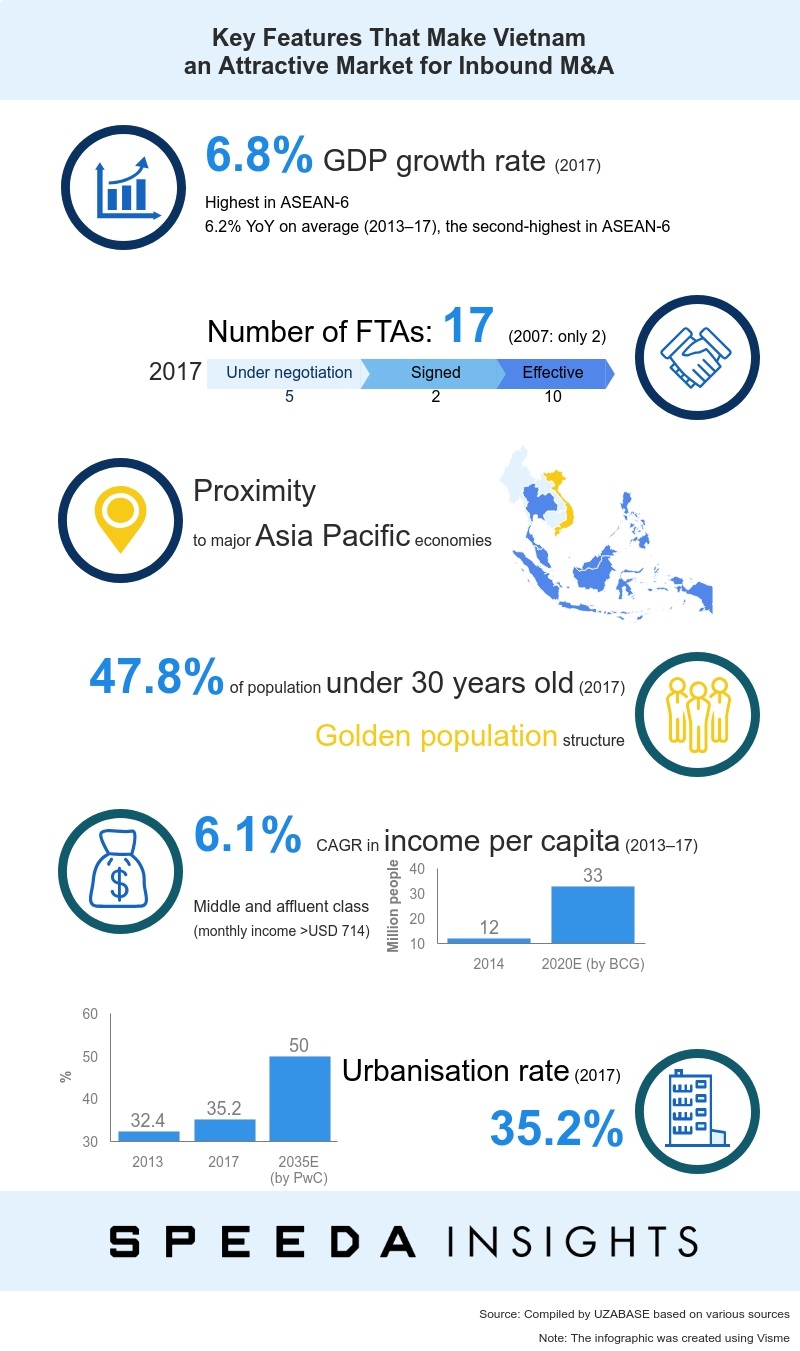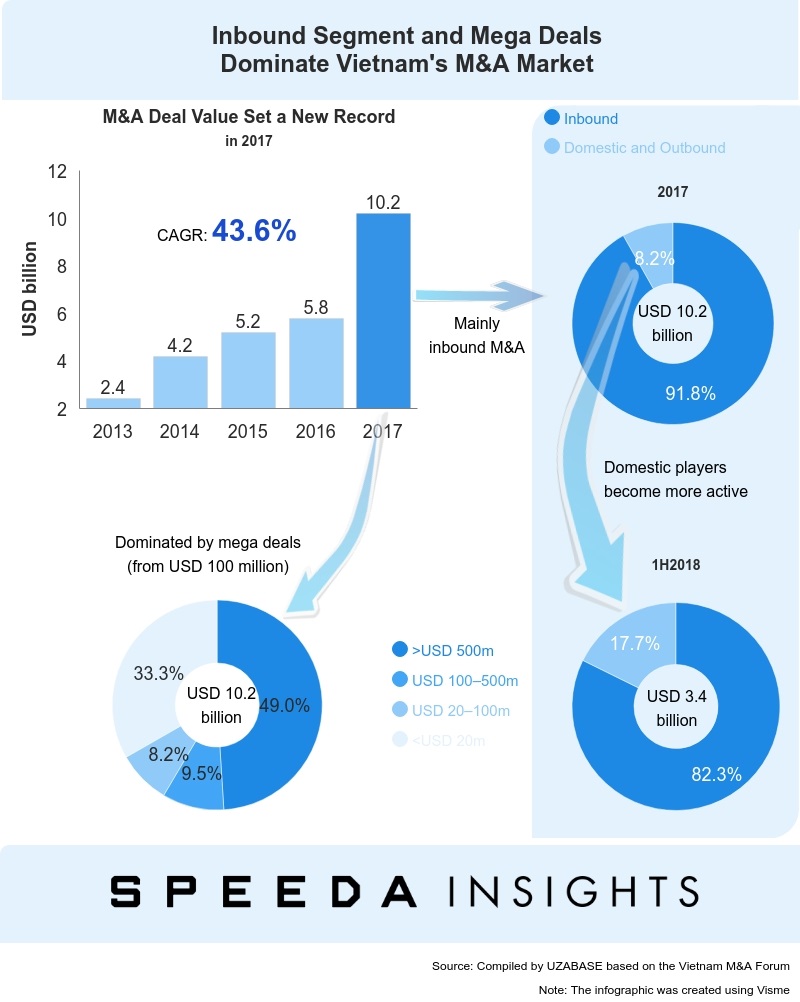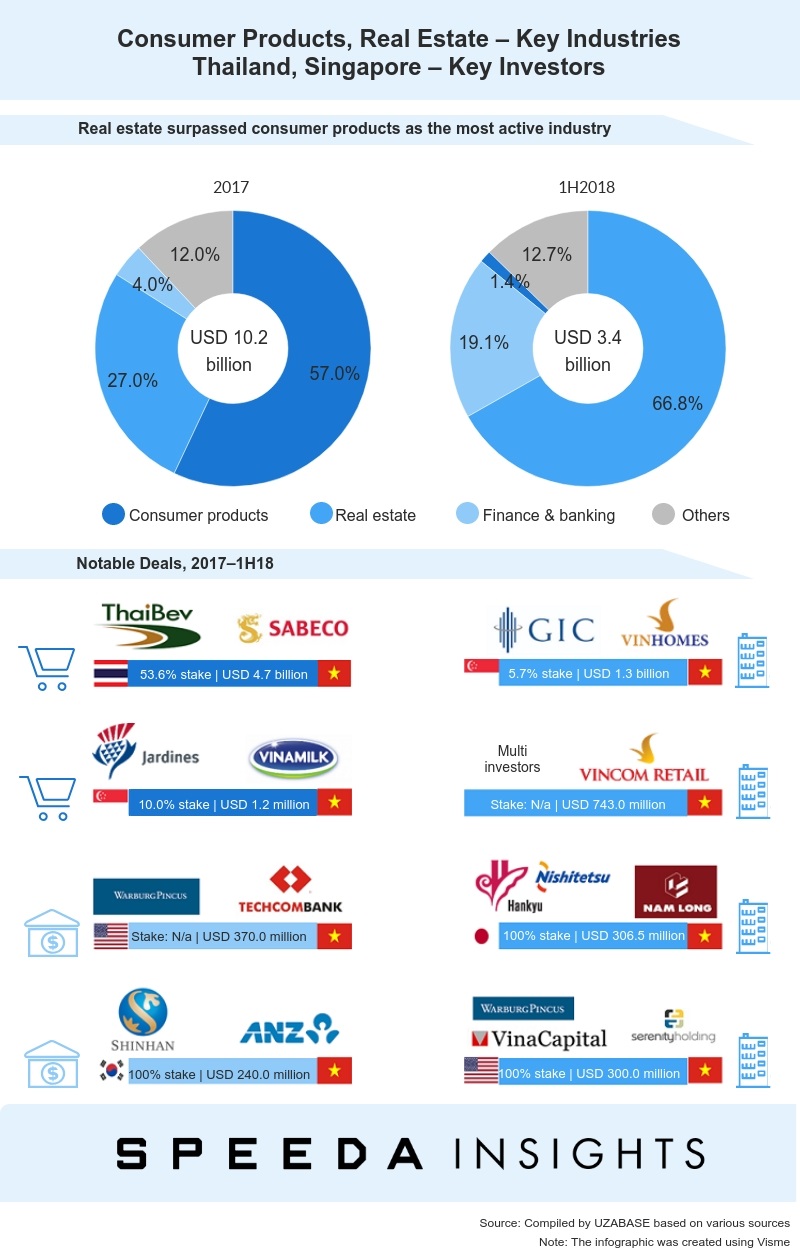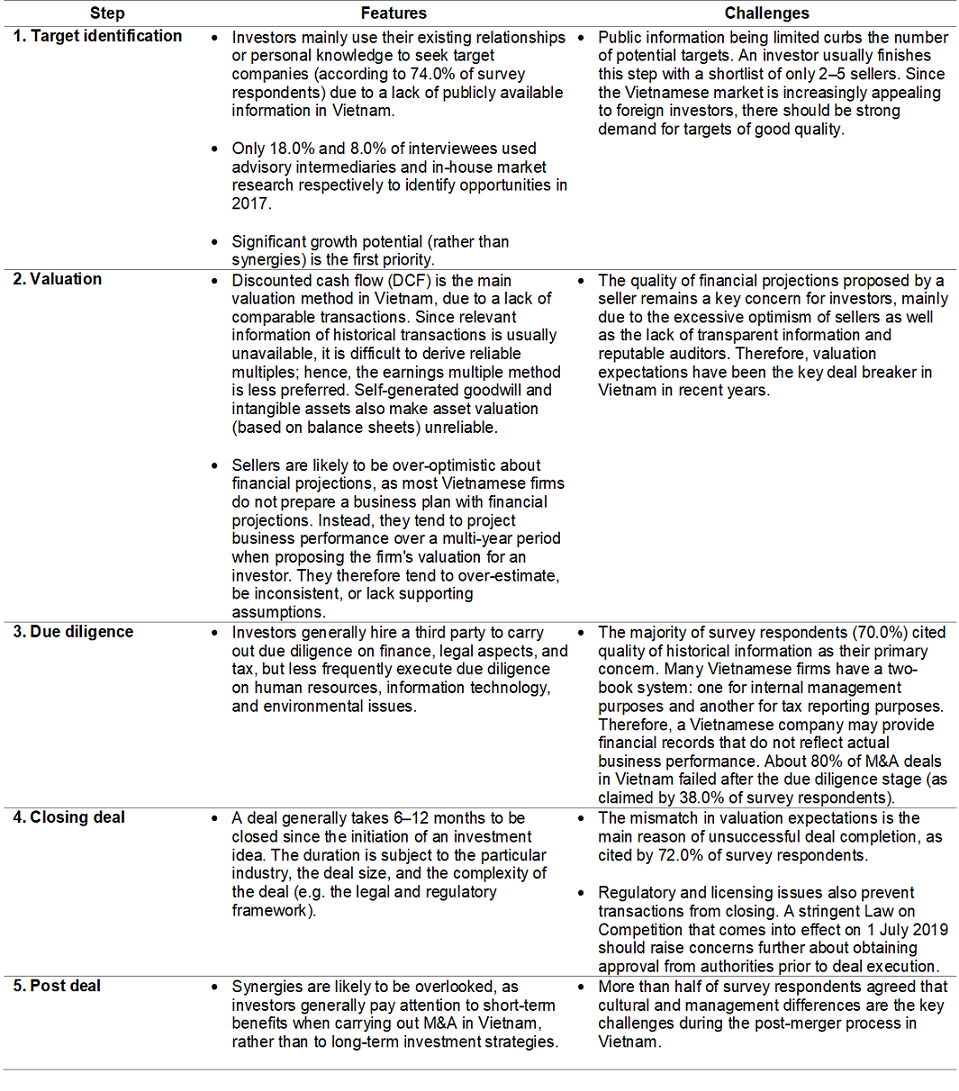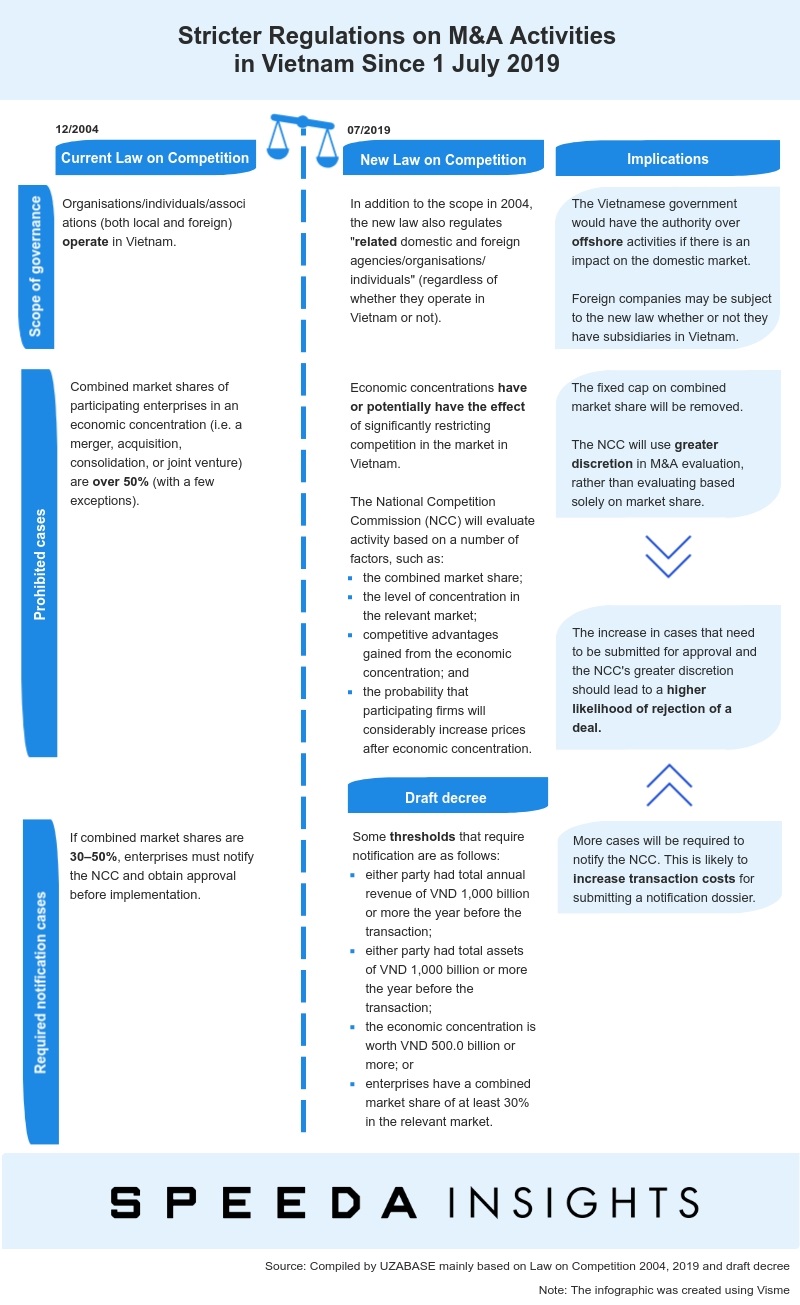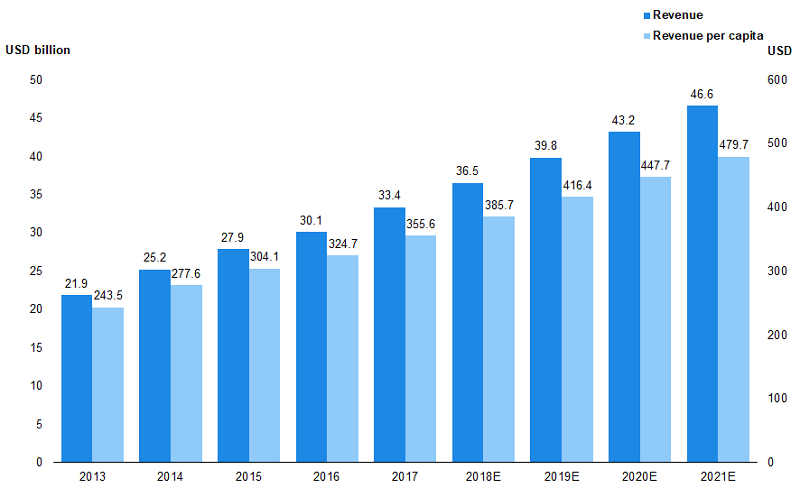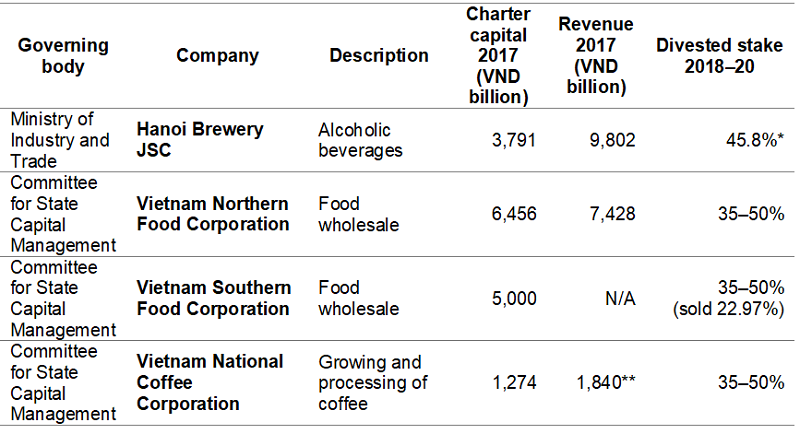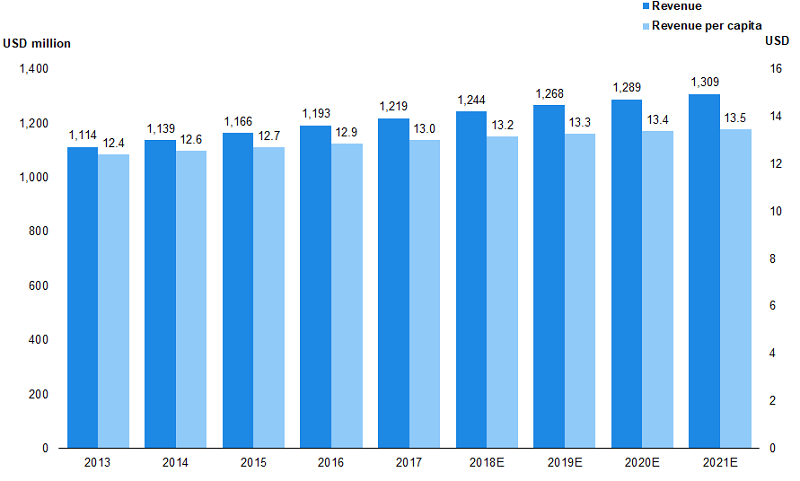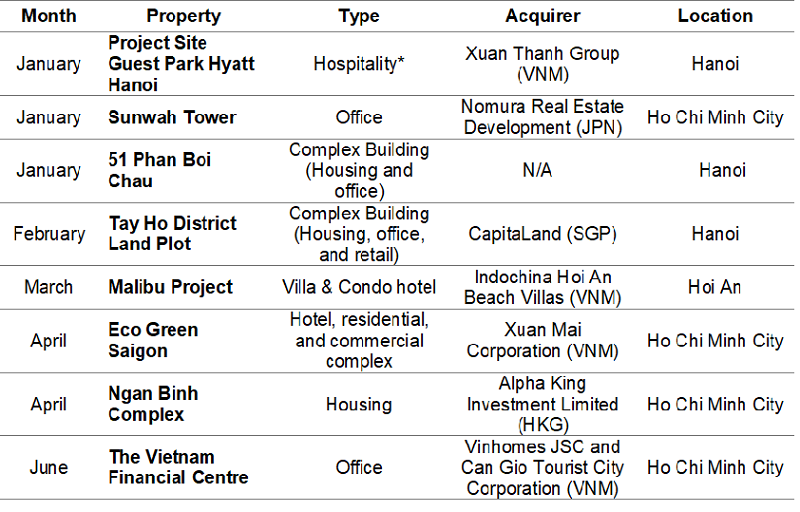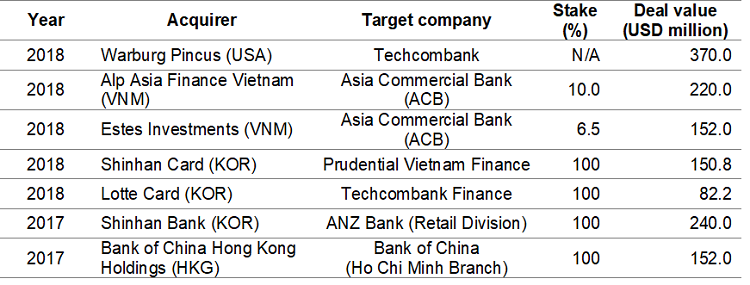Vietnamese M&A Landscape: Promising Themes
|
A lucrative market for inbound M&A, Vietnam has seen M&A activity surge over the past few years, supported by the country’s positive macroeconomic fundamentals and favourable demographics. Both deal value and volume have increased at impressive CAGRs of 43.6% and 11.2% respectively over 2013–17. In 2017, deal value rose 75.3% YoY to USD 10.2 billion, particularly on the back of a record-breaking acquisition of a stake (53.6%) in Saigon Beverage Company (SABECO) by Thai Beverage (ThaiBev) in a deal valued at USD 4.7 billion. |
|
While Vietnam offers numerous appealing targets for M&A, a lack of transparency in terms of publicly available information remains the most challenging obstacle in the process of identifying M&A targets. Next, sellers’ over-optimism and shortage of comparable transactions pose barriers in the valuation process. The number of successful M&A deals after due diligence in Vietnam is thus relatively low, partially due to the misalignment of value expectations between participants. During the final stages, a stricter Law on Competition, effective from 1 July 2019, may cause more concern about licensing issues. |
|
Despite these challenges, KPMG expects the Vietnamese M&A landscape to remain one of positive growth, with food and beverage, pharmaceuticals, real estate, and banking set to be the most active industries in the coming years. |
|
M&A Activity Review: 2017–1H18 |
|
Vietnam Sees New Record in M&A Deal Value in 2017, Supported by Mega Inbound Deals |
|
According to KPMG (‘Pursuing M&A in Vietnam’ report), Vietnam has been one of the most attractive and vibrant M&A destinations in Southeast Asia since 2013. In general, the country offers a number of positive attributes that attract inbound M&A, including a fast-growing economy, increasing free trade agreements, a strategic location at the centre of Southeast Asia (connecting to a regional marketplace of more than 600 million people), a young labour force, improving per-capita income, a growing middle class, and rapid urbanisation. In addition, the Vietnamese government has also made significant efforts to create a healthier business environment, boosting both the quantity and the quality of M&A in the country. Vietnam ranked 55th among 137 countries surveyed in the World Economic Forum’s Global Competitiveness Index 2017–18, up 20 places from five years ago. In taking advantage of these favourable conditions, investors might prefer M&A to greenfield investments, as the former is a less risky and faster investment channel. |
|
|
|
Vietnam’s M&A deal value set a new record of USD 10.2 billion (4.6% of GDP) in 2017, surging by 75.3% YoY and registering an impressive CAGR of 43.6% over 2013–17 (based on the Vietnam M&A Forum [MAF]). In 1H2018, M&A value came in at USD 3.4 billion, up by about 55% YoY from 1H2017. The inbound M&A segment continues to dominate M&A deals, with an 82.3% market share in 1H2018, despite domestic players’ increasing participation in the market. According to StoxPlus, the number of inbound M&A deals more than doubled to 146 transactions during 2013–17. |
|
The impressive growth in Vietnam’s M&A market during 2017–1H18 was driven primarily by ‘mega deals’ (deals of over USD 100.0 million in value). In particular, mega deals captured 76.1% of total M&A deal value in 1H2018, up 17.5 percentage points from the level in 2017. With regard to deal numbers, mega deals accounted only for about 7% of the total number of M&A deals in 1H2018 (2017: about 8%). Small-sized deals (USD 3–4 million) remain the most popular M&A deal size in Vietnam, accounting for about 90% of the total number of deals in 2017 (KPMG’s report). In effect, Vietnam’s M&A market is characterised by (1) a large number of significantly small deals and (2) a small number of considerably large deals. |
|
|
|
Consumer Products and Real Estate the Most Active Sectors, Driven Mainly by Investments from Thailand and Singapore Respectively |
|
Consumer products was the most active sector in M&A in Vietnam during 2007–17, according to KPMG Vietnam. The sector dominated Vietnam’s M&A market particularly in 2017, accounting for 57.0% of total deal value, up 34.5 percentage points from the 2016 level. According to the MAF, M&A deal value in the consumer products sector in Vietnam increased 4.4x YoY to USD 5.8 billion in 2017, driven mainly by the record-breaking ThaiBev-SABECO deal: in December 2017, ThaiBev (THL) acquired a 53.6% stake in SABECO (the largest state-owned brewery in Vietnam) at USD 4.7 billion, in order to gain the widest distribution network and around 40% of Vietnam’s beverage market share (2016). This transaction accounted for 46.1% of total M&A deal value in 2017, being the largest M&A deal not only in Vietnam, but also in Southeast Asia. |
|
Apart from ThaiBev, many Thai companies have aggressively expanded to overseas markets via M&A, partially due to domestic market saturation in recent years. Vietnam has become one of the most preferred destinations for M&A by Thai companies — apart from its favourable economic and geographic conditions, the country’s cultural values and lifestyle are closely related to Thailand’s. For example, in 2016, Central Group (THA) acquired 100% of Big C Vietnam (super- and hyper-market) from French Retailer Casino (valued at USD 1.1 billion, equivalent to 18.9% of total deal value in 2016); Berli Jucker (THA) acquired Metro C&C (super- and hyper-market) from Metro Group (DEU) (USD 727.0 million, 12.5%). |
|
While Thai investors generally focus on retail and consumer goods, Singaporean investors tend to concentrate on real estate. The largest deal in 1H2018 was GIC Pte Ltd’s (SGP) acquisition of a 5.7% stake (valued at USD 1.3 billion) in Vinhomes, representing 38.2% of total deal value in 1H2018. Singapore thereby surpassed Thailand to the dominant position in Vietnam’s M&A market in 1H2018. It is not only Singaporean investors who show increasing interest in Vietnam’s real estate market, but others as well (e.g. investors from Japan and the USA). This is explained by (1) Vietnam’s recovery from the housing crisis of 2009–13 and its growing property market and (2) its emerging market status, which offers higher yield opportunities compared with matured markets. M&A market value from the real estate sector accounted for the largest proportion (66.8%) of total deal value in Vietnam in 1H2018. Deal value in this sector grew nearly fivefold to USD 2.8 billion (27.0% of total deal value in 2017) from just USD 560.5 million (9.6% of total deal value in 2016) over 2016–17. In particular, the inbound segment (especially inbound capital from Singapore in recent times) has been the main capital source of M&A real estate deals in Vietnam. Only four domestic mega deals, valued at about USD 153–516 million (20.1% of total real estate deal value), were recorded during 2017–1H18. |
|
|
|
Conducting M&A: Current Challenges |
|
Main Features and Key Challenges in Conducting M&A in Vietnam |
|
Although Vietnam’s macroeconomic fundamentals are positive, with a multitude of appealing M&A targets, conducting M&A in the country comes with various difficulties. A lack of publicly available information and accuracy in financial reports are key factors that limit the number of targets as well as the number of successful deals passing through due diligence. Mismatches in valuation expectations with overly aggressive projections predicted by sellers have also been a key deal breaker in recent years. The following table provides a more detailed analysis of the features as well as the key challenges faced during each step. |
|
Carrying out M&A in Vietnam |
|
|
|
Source: Summarised by UZABASE based on KPMG Vietnam, “Pursuing M&A in Vietnam” |
|
New Law on Competition Effective in 2019 Increases Concerns About Licensing Issues |
|
At present, M&A activities in Vietnam are governed mainly by the Law on Competition 2004. The National Assembly of Vietnam passed the new law in June 2018, and it will come into effect on 1 July 2019. In addition, a draft decree guiding the new Law on Competition is also proposed and under consideration. Since the new regulations will be more stringent, they are likely to raise more concerns about regulatory and licensing issues among M&A participants. Based on KPMG’s survey, at least half the deals in real estate and energy sectors failed due to regulatory and licensing problems in Vietnam. |
|
|
|
Promising Themes in Coming Years |
|
Food and Beverages: To Remain the Most Promising Industry for M&A Deals, Driven by Favourable Demographics |
|
KPMG Vietnam reported that 46.0% of survey participants considered the food and beverage (F&B) sector as the most favourable for M&A in Vietnam. This expectation is driven primarily by a potential consumption market of 95.4 million people (2017), a growing middle-income and affluent class (2020E: 34.2% of the population, up from 13.2% in 2014, based on BCG and IMF), foreign brand penetration, and rapid expansion in the retail sector. Demand for diverse F&B products among residents of major cities, from healthy and natural products to fast foods, has strongly supported Vietnam’s F&B sector. Furthermore, being a tropical agricultural country, Vietnam provides plenty of ingredients for F&B products. The distribution channel for these products has also widened considerably owing to the impressive expansion of convenience stores (1,600 convenience stores in 2016, up 10.9x from 2012). |
|
According to Statista, total F&B revenue in Vietnam recorded an 11.1% CAGR over 2013–17 to USD 33.4 billion (14.9% of GDP in 2017). Statista forecasts revenue to increase at a CAGR of 8.7% through 2017–21E to USD 46.6 billion. Per-capita revenue from F&B grew at a CAGR of 9.9% during 2013–17 to USD 355.6 and is expected to rise at a 7.8% CAGR over 2017–21E to USD 479.7. |
|
Food and Beverage Sector’s Revenue and Average Revenue per Capita Both Increasing in Vietnam over 2013–21E |
|
|
|
Source: Calculated by UZABASE based on Statista |
|
Regarding M&A activities, investors tend to focus on the large companies on account of their leading positions and strong brand value. The largest deal in 2017 was the capital divestment of SABECO, the leading company in the brewery industry. Some F&B sector state-owned enterprises (SOEs) that have officially announced their divestment plans are Hanoi Brewery JSC (HABECO), Vietnam National Coffee Corporation (Vinacafe), Vietnam Northern Food Corporation (Vinafood 1), and Vietnam Southern Food Corporation (Vinafood 2). |
|
Interesting Targets for M&A in Vietnam’s F&B Sector |
|
|
|
Source: Compiled by UZABASE based on various sources |
|
Note: *Assuming HABECO’s divestment plan follows SABECO’s schedule |
|
**Figure is as of 2016 |
|
Pharmaceuticals: Likely to Be Favoured by Foreign Investors for Fast Market Entry |
|
According to KPMG Vietnam, pharmaceuticals are the second most popular sector for M&A in Vietnam, chosen by 38.0% of survey respondents. Some investors consider M&A as an effective means to obtain compulsory licenses in Vietnam. In addition, increasing demand for healthcare products and per-capita medical spending as well as the government’s plan to simplify licensing policies are other drivers of Vietnam’s pharmaceutical industry. A state-owned pharmaceutical company, Vietnam Pharmaceutical Corporation (Vinapharm), is likely to be a potential target for M&A investors, given the Ministry of Health’s plan to divest 30.0% of its stake by 2018. |
|
The total market for over-the-counter (OTC) pharmaceuticals grew at a 2.3% CAGR over 2013–17 to USD 1.2 billion (0.54% of GDP in 2017). Statista forecasts revenue to increase at a CAGR of 1.8% through 2017–21E to USD 1.3 billion. Per-capita revenue from OTC pharmaceuticals in Vietnam grew at a CAGR of 1.2% during 2013–17 to USD 13.0 and is expected to rise at a 0.85% CAGR over 2017–21E to USD 13.5. |
|
OTC Pharmaceutical Revenue and Average Revenue per Capita Both Increasing Steadily in Vietnam over 2013–21E |
|
|
|
Source: Statista |
|
Real Estate: Growing Urbanisation and Tourism to Boost M&A in Residential and Hospitality Segments |
|
The real estate sector (especially the residential and hospitality segments) is likely to be an appealing investment channel into Vietnam for foreign investors, given the country’s rapidly increasing urbanisation rate and number of tourists. Vietnam’s urbanisation rate rose 2.8 percentage points to 35.2% during 2013–17 (World Bank), and PwC expects it to reach about 50% by 2035E. According to the General Statistics Office of Vietnam, the number of foreign visitors to Vietnam grew at a CAGR of 14.3% over 2013–17 to 12.9 million (except for a minimal decline of 0.20% YoY in 2015). Inbound tourists are mainly from China (31.0% in 2017) and South Korea (18.7%) due to their proximity to Vietnam. The number of domestic tourists in Vietnam also surged at a CAGR of 20.3% to 73.2 million over 2013–17. |
|
Vietnam’s real estate market attracts foreign investors from different countries such as Singapore, Japan, the USA, South Korea, and China. Alongside foreign players, domestic investors have been increasingly seeking real estate deals recently. Appealing projects are likely to be located in major cities or tourism destinations such as Hanoi, Ho Chi Minh City, and Hoi An. |
|
Notable M&A Real Estate Projects Located Mainly in Vietnam’s Big Cities, 1H2018 |
|
|
|
Source: Compiled by UZABASE based on various sources |
|
Note: List is not exhaustive |
|
* Type of project has not been approved by the authority yet |
|
Banking: Government Efforts to Restructure Vietnam’s Credit Institution System and Foreign Investor Interest in Untapped Retail Segment to Be the Main Drivers |
|
M&A in Vietnam’s banking industry is likely to warm up, as the Vietnamese government has expedited the restructuring of credit institutions. The government strongly encourages the M&A of small-sized banks into large-sized ones, as this could help the country establish major banks in Southeast Asia by 2021. Vietnam Bank for Agriculture and Rural Development (Agribank), one of the four largest state banks in Vietnam, is aiming for an initial public offering (IPO) in 2019. The government also intends to reduce the state capital in Bank for Investment and Development of Vietnam (BIDV) and JSC Bank for Foreign Trade of Vietnam (VCB) (two of the top four state banks in Vietnam) by selling shares to foreign and domestic investors. |
|
In addition, in August 2018, the Vietnamese government announced its intention not to issue new licences for the establishment of 100% foreign-owned banks in Vietnam. Instead, foreign banks are encouraged to acquire underperforming domestic banks and to then restructure them to bolster management efficiency. |
|
From the investor side, foreign players are increasingly keen on Vietnam’s banking market due to its substantial untapped retail potential (only 30.8% of the population aged 15 and above had an account at a financial institution as of 2017). In particular, Vietnam’s consumer finance market has experienced strong growth in recent years (52.3% CAGR over 2013–17). |
|
Meanwhile, the success of some South Korean banks in Vietnam has South Korean financial investors paying special attention to Vietnam’s banking industry. According to the National Financial Supervisory Commission, Hana Financial Group (KEB Hana Bank) (KOR) is preparing to buy shares of BIDV (VNM). In addition, at the beginning of 2018, Shinhan Card (KOR) acquired Prudential Finance (VNM), while Lotter Card (KOR) acquired Techcombank Finance (VNM). |
|
M&A Deals in Vietnam’s Banking Industry, 2017–1H18 |
|
|
|
Source: Compiled by UZABASE based on various sources |




